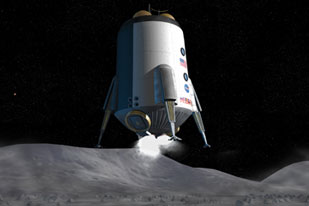US to build base on Moon
The project will begin with crews, on short vists, building solar-powered living quarters.

The US space agency said in a statement that it had focused its Global Exploration Strategy, first outlined in April, on two issues: “Why we are returning to the moon and what we plan to do when we get there.”
International effort
Nasa said it pulled together detailed answers to those questions by polling more than 1,000 experts, from 13 other space agencies, including those of China, India, Russia and Ukraine, and from public and private organisations and businesses, including commercial space exploration operations.
 |
| Nasa concept drawing of a large lunar lander |
“This strategy will enable interested nations to leverage their capabilities and financial and technical contributions, making optimum use of globally available knowledge and resources to help energise a coordinated effort that will propel us into this new age of discovery and exploration,” a Nasa administrator said.
The project will begin with four person crews visiting the moon on a series of week-long visits to build up a living quarters with its own power units and lunar exploration vehicles.
In the current plan, the first mission will be launched by 2020. Before human missions are started, unmanned robotic missions will be undertaken to lay the groundwork, handling landing site reconnaissance, natural resource assessments, and technology risk checks.
Trip to Mars
After the permanent facilities are established, visits as long as 180 days can be made to plan, for example, trips to Mars.
 |
| The US envisions the human exploration of Mars (Picture: Nasa/Pat Rawlings, SAIC) |
Nasa, Russia and the European Space Agency are currently constructing the International Space Station in orbit around the Earth which could itself be a springboard and operations base for the moon programme.
On Thursday, Nasa’s space shuttle Discovery will launch on the newest construction mission to the ISS, one of 14 planned between now and 2010 to complete the building of the ISS before the aging shuttle fleet is retired.
“Nasa’s goal is to enable a sustainable space exploration effort in which participating organisations can achieve individual goals with mutually beneficial results,” said one official.
Nasa’s lunar programme plans, under the Global Exploration Strategy, are being laid out in a Space Exploration Conference on December 4-6 in Houston, Texas.